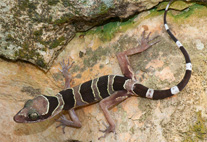Abstract
A new fossil filefish, Aluterus shigensis sp. nov., with a close resemblance to the extant Aluterus scriptus (Osbeck), is described from the Middle Miocene Bessho Formation in Nagano Prefecture, central Japan. It is characterized by: 21 total vertebrae; very slender and long first dorsal spine with tiny anterior barbs; thin and lancet-shaped basal pterygiophore of the spiny dorsal fin, with its ventral margin separated from the skull; proximal tip of moderately slender first pterygiophore of the soft dorsal fin not reaching far ventrally; soft dorsal-fin base longer than anal-fin base; caudal peduncle having nearly equal depth and length; and tiny, fine scales with slender, straight spinules. The occurrence of this fossil filefish from the Bessho Formation is consistent with the influence of warm water currents suggested by other fossils, but it is inconsistent with the deep-water sedimentary environment of this Formation. This is the first fossil occurrence of a filefish in Asia; previously described fossil filefishes are known from the Pliocene and Pleistocene of Italy, the Pliocene of Greece, and the Miocene and Pliocene of North America. These fossil records suggest that the genus Aluterus had already been derived and was widely distributed during the Middle Miocene with taxa closely resembling Recent species.

